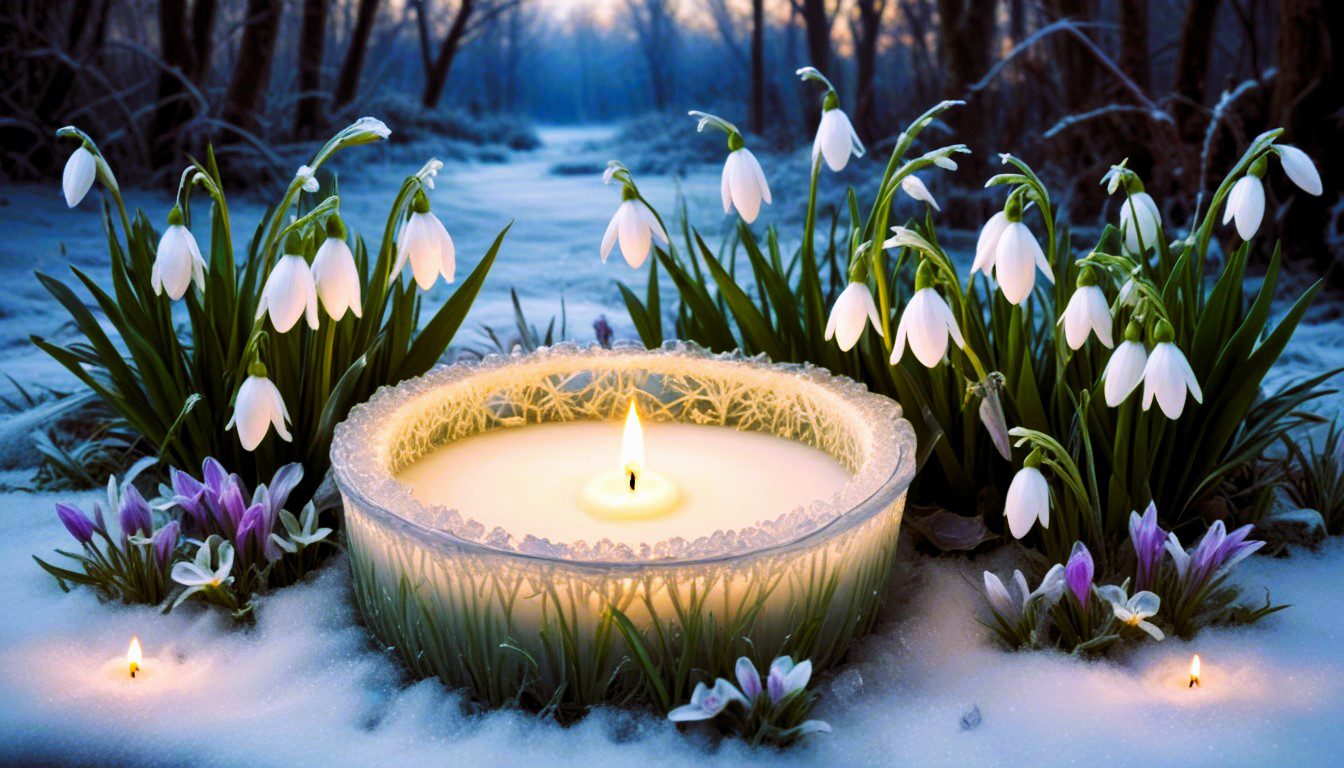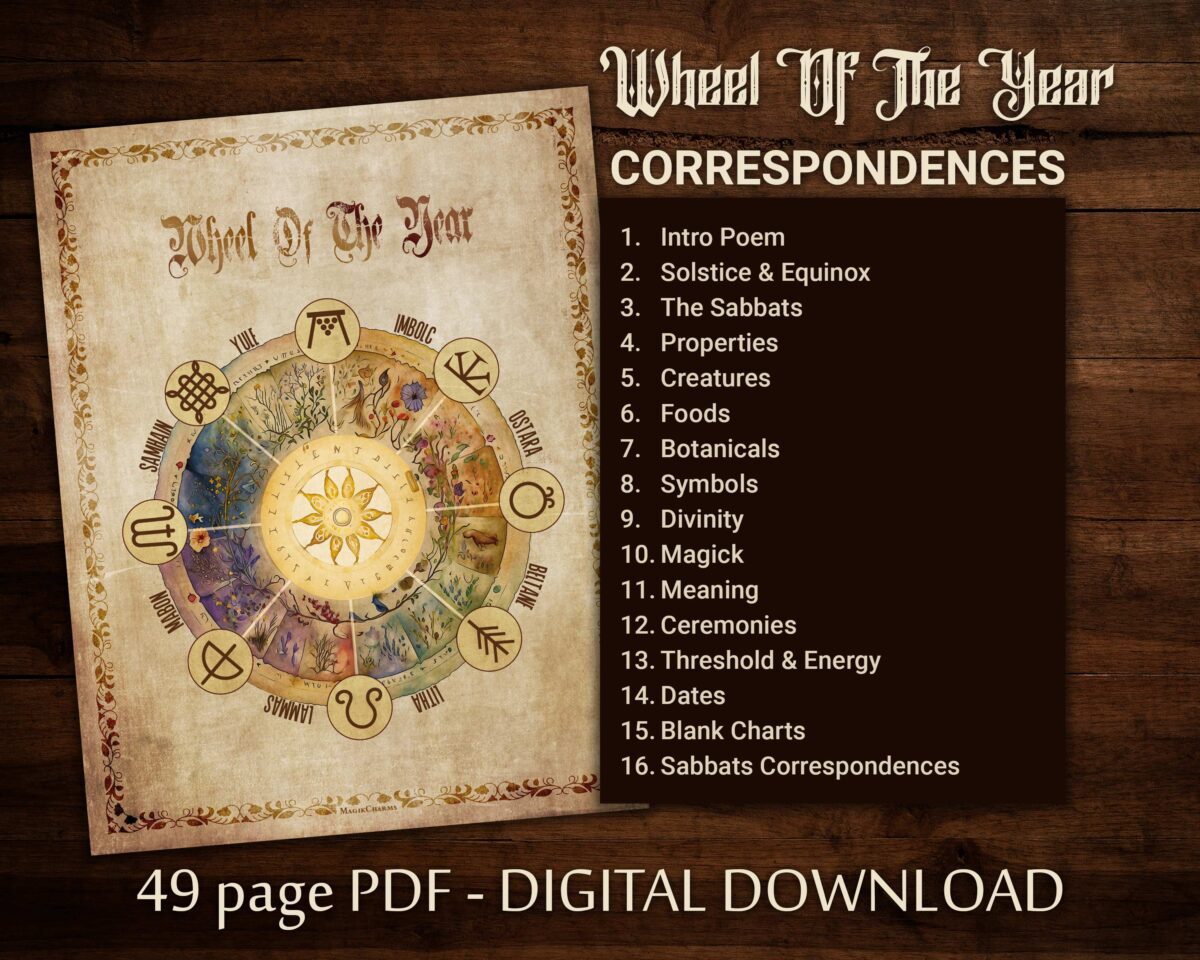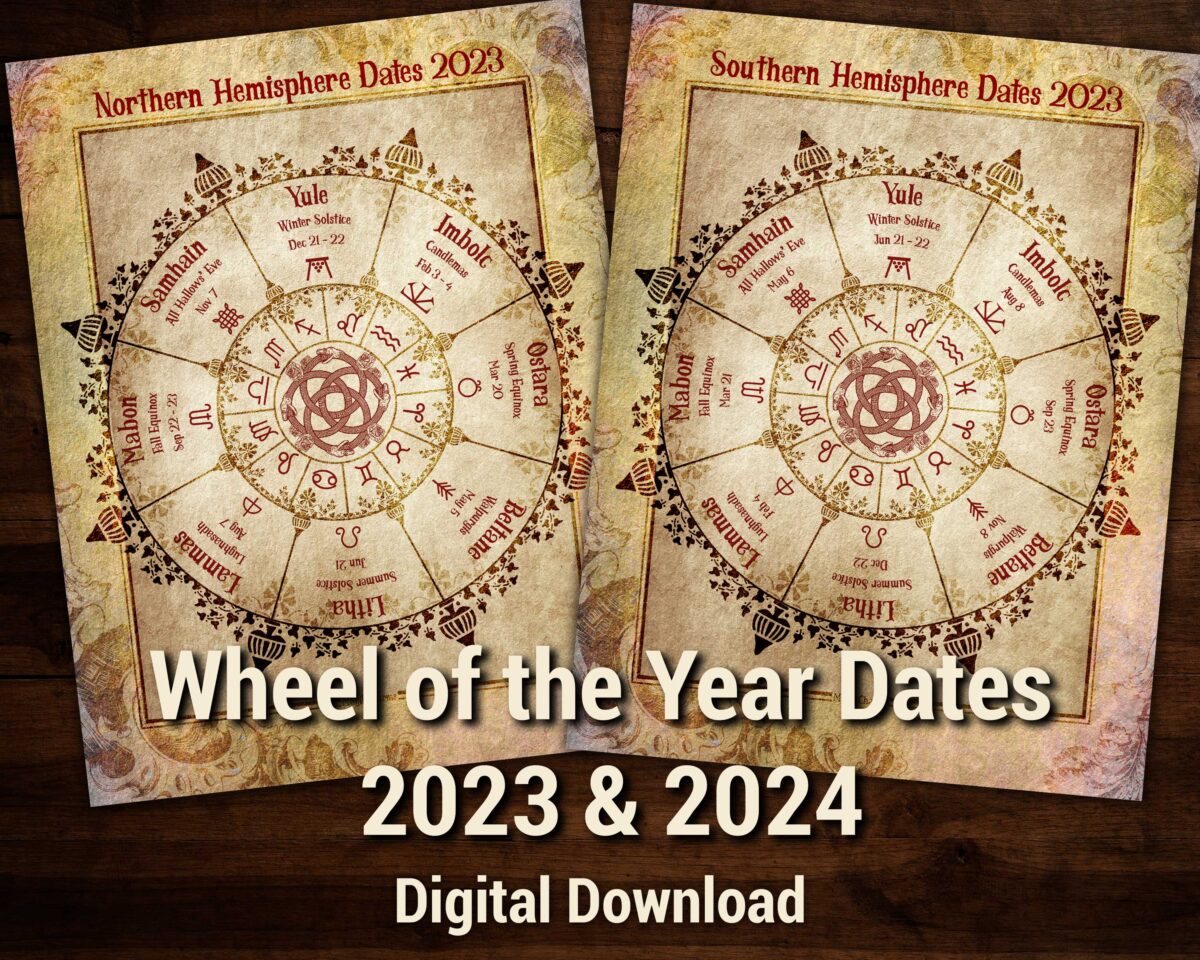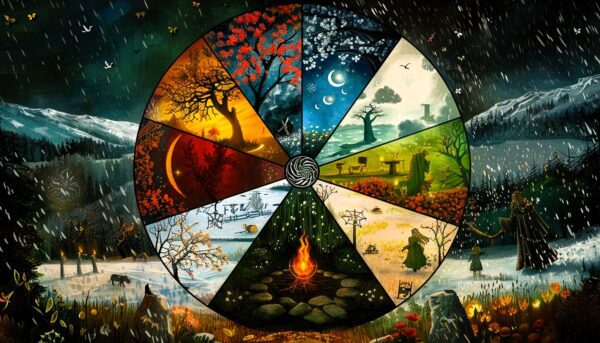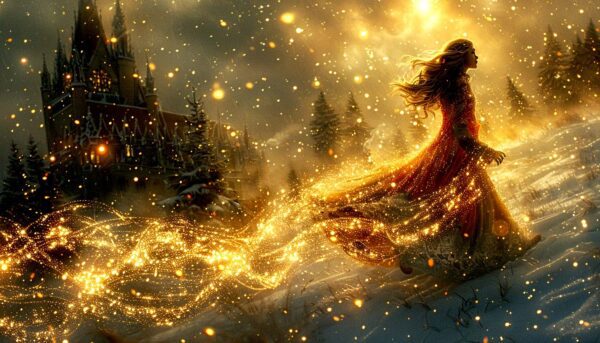- What is Imbolc?
- Colors, Symbols, and Deities of Imbolc
- Creating a Sacred Space: The Imbolc Altar
- Imbolc Celebrations: Welcoming the Coming Spring
- A Sample Imbolc Ritual
- Beyond Ritual: Embracing the Spirit of Imbolc
- Imbolc Crafts and Activities for Children
- Imbolc Around the World
- Conclusion: The Blessings of Imbolc
Unveiling the Magick of Imbolc: A Celebration of Hope and Light
Feel that subtle shift in the air? Winter’s grip loosens, and days grow noticeably longer. It’s a sign of Imbolc (pronounced IM-bulk) approaching, a vibrant festival steeped in history and symbolism!
What is Imbolc? Celebrated around the 1st of February in the Northern Hemisphere and the 1st of August in the Southern Hemisphere, Imbolc bridges the gap between winter and spring. Imagine it as a gentle nudge towards warmer days.
A Whisper of Spring Awakening While snow may linger, Imbolc signifies a beautiful transformation. The first blooms peek through, symbolizing rebirth and the potential for growth waiting to explode.
Themes of Imbolc:
- Purification: Rituals cleanse your space, both physical and spiritual, making way for fresh beginnings.
- Rebirth: The earth awakens, mirroring a time for personal renewal and setting intentions for the coming months.
- Light: Candles are lit, chasing away winter’s darkness and illuminating the path towards spring’s brilliance.
A Look Back: Imbolc’s Rich History Imbolc’s roots are ancient, connecting it to Celtic traditions. Back then, it was a time to celebrate sheep giving milk again after winter – a crucial event for agricultural communities.
Brigid’s Day: Honoring a Powerful Goddess Imbolc is also deeply associated with Brigid, a Celtic deity representing creativity, healing, poetry, and smithcraft. Many call it Brigid’s Day, a time to honor this multifaceted goddess and her blessings for the coming year.
Whether you’re drawn to Imbolc’s historical significance, the promise of spring’s return, or the inspiration of Brigid’s spirit, this festival offers a wealth of opportunities for personal reflection and celebration. Get ready to dive deeper into the magick of Imbolc! In the following sections, we’ll explore its symbols, traditions, and rituals to help you embrace the light and hope of this beautiful time.
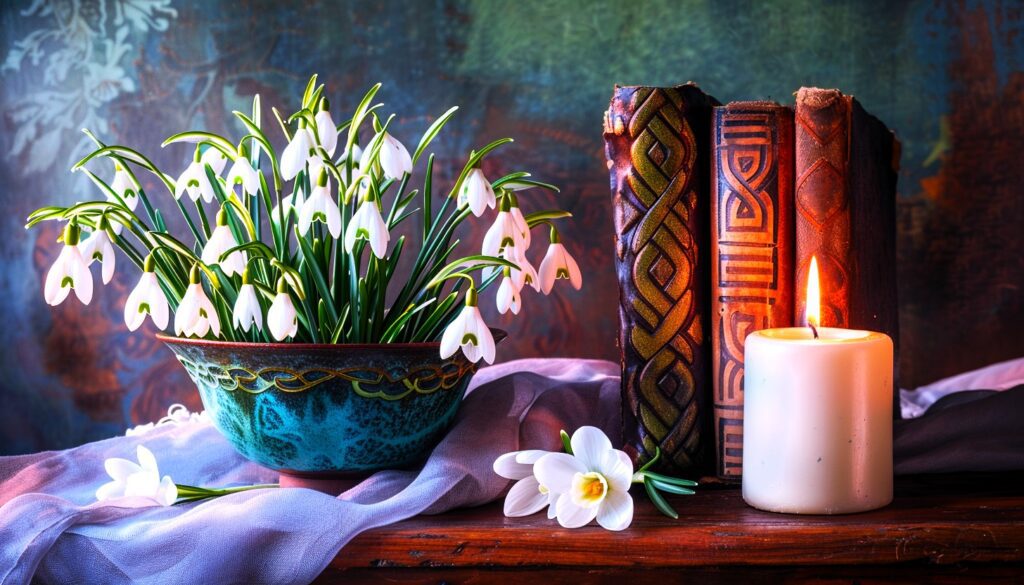


Unveiling the Colors, Symbols, and Deities of Imbolc
Imbolc, a vibrant festival heralding the whispers of spring, is rich in symbolism and tradition. Let’s delve into the colors, symbols, and deities associated with this magickal time.
Colors of Imbolc: Painting a Hopeful Palette
- White: Purity and new beginnings take center stage at Imbolc. White decorations, candles, and clothing symbolize the cleansing of winter’s remnants and the fresh start that spring promises.
- Green: A hint of green peeks through the winter slumber, representing the potential for growth and the fertile earth awakening from its dormancy.
Imbolc’s Symbolic Language
- Candles: Fire plays a key role in Imbolc rituals. Candles symbolize the returning light, dispelling winter’s darkness and illuminating the path towards spring’s warmth.
- White Flowers: Snowdrops, brave enough to bloom amidst the chill, represent hope, resilience, and the delicate beauty of new beginnings.
- Lambs: Newborn lambs embody the innocence and purity associated with Imbolc. They represent the potential for new life and the cycle of rebirth inherent in nature.
- Brigid’s Cross: Woven from straw or rushes, Brigid’s Cross is a powerful symbol of protection, fire, and the blessings of the Celtic goddess Brigid. It’s often hung above doors or windows to ward off negativity and welcome good fortune.
Deities of Imbolc: Invocations for Hope and Renewal
- Brigid (Celtic): The most prominent deity associated with Imbolc is Brigid, the Celtic goddess of fire, poetry, healing, and smithcraft. Her feast day often falls around Imbolc, and she’s invoked for inspiration, creativity, and protection during this time of new beginnings.
- Juno (Roman): The Roman goddess Juno, protector of women and childbirth, also finds connections to Imbolc. As spring stirs, Juno is seen as a symbol of fertility and the potential for new life.
- Freya (Norse): The Norse goddess Freya, associated with love, beauty, and fertility, also resonates with the themes of Imbolc. She’s invoked for blessings of love, prosperity, and a bountiful harvest in the coming months.
These colors, symbols, and deities all weave together a tapestry of hope and renewal, perfectly capturing the essence of Imbolc. As you celebrate Imbolc, incorporate these elements into your rituals and decorations to connect with the magick of this beautiful festival.



Craft Your Imbolc Altar: A Beacon for Spring’s Arrival
Imbolc, the festival heralding spring’s approach, calls for a vibrant altar to reflect the awakening earth. Here’s how to create a sacred space that sparks joy and welcomes the season’s energy.
Set Your Imbolc Intention
Before gathering elements, take a moment to set your intention. What do you hope to cultivate during Imbolc? Is it increased creativity, a sense of renewal, or a connection to the burgeoning life force? Choose an intention that resonates with you and let it guide your altar’s creation.
Essential Elements for an Imbolc Altar
- Colored Cloths: Opt for green or white cloths. Green represents the awakening earth, while white symbolizes new beginnings and purification – perfect for Imbolc’s themes.
- Candles: Choose candles in colors that mirror your intention. Green or white candles promote new beginnings and growth, while yellow candles invite warmth and optimism.
- Bowls: Fill a bowl with fresh water to represent purification and life-giving energy. Another bowl can hold offerings to the deities or seeds for future planting.
- Spring Symbols: Freshly cut flowers like snowdrops or daffodils symbolize the resilience of life pushing through winter. Pinecones represent potential and hidden life waiting to bloom.
Embrace Nature’s Touch
Imbolc celebrates nature’s awakening. Incorporate natural materials like twigs, stones, or seashells found on winter walks. These elements connect your altar to the earth’s magick.
Blooms and Purification
White flowers, like lilies or white roses, add a touch of elegance and symbolize purity. Place them in a vase or arrange them around your candles. Imbolc is also a time for cleansing. Include objects like seashells or white stones as symbols of purification, washing away negativity to welcome new beginnings.
Remember, your Imbolc altar is a personal space. Let your creativity flow and choose elements that resonate with you. As you create your sacred space, focus on your intention, and feel the anticipation of spring’s vibrant arrival.
Imbolc Celebrations: Welcoming the Coming Spring
Imbolc, a vibrant festival arriving around February 1st, marks the halfway point between winter’s slumber and spring’s awakening. It’s a time to cleanse, plant seeds (both literal and metaphorical), and celebrate the burgeoning light and hope for the coming season. Here’s how you can embrace the spirit of Imbolc and welcome the whispers of spring:
Purification Rituals: Cleansing for New Beginnings
Imbolc is a time for cleansing, both physically and spiritually. Make space for the new growth to come by clearing away the stagnant energy of winter. Here are some ideas:
- Smudging: Light a bundle of sage, rosemary, or lavender and use the smoke to cleanse your home and yourself. Visualize negativity and stagnant energy carried away by the smoke.
- Meditation: Take some quiet time to meditate, focusing on releasing burdens and anxieties. Imagine yourself enveloped in white light, purifying your spirit and preparing for new beginnings.
- Spring Cleaning: Give your home a thorough cleaning! Open the windows, let in fresh air, and declutter your space. This physical cleansing creates space for new energy to flow.
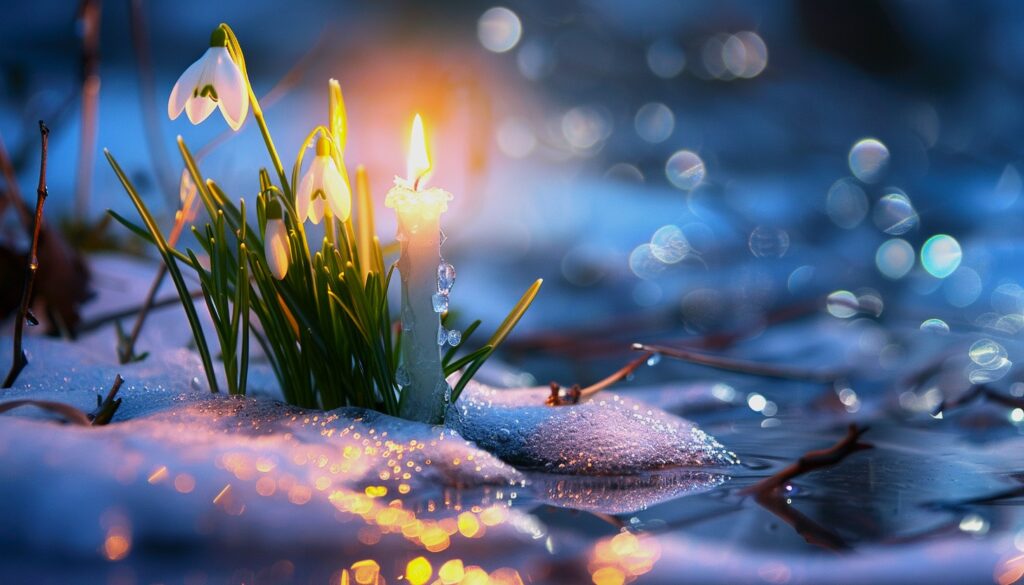


Candle Magick: Lighting the Way for Your Wishes
Candlelight is a potent tool in Imbolc celebrations. Choose white or yellow candles, representing purification and the returning sun. Here’s a simple candle spell you can perform:
- Write your intention: On a piece of paper, write down a wish or a goal you want to manifest in the coming spring. Be clear and concise.
- Anoint the candle: If you like, anoint your candle with a few drops of an oil that resonates with your intention (e.g., lavender for calmness, rosemary for focus).
- Light the candle and visualize: Light your candle and focus on your written intention. Visualize your wish coming to fruition, feeling the energy building within you.
- Release your intention: Once the candle has burned down completely, or when you feel ready, take the paper and burn it safely in a fireproof container. As the paper burns, visualize your intention being released into the universe.
Seed Planting: A Symbol of Growth, Both Literal and Metaphorical
Planting seeds during Imbolc is a powerful act, symbolizing the potential for growth and new beginnings. Here are two ways to embrace this tradition:
- Plant real seeds: Start seeds for herbs, flowers, or vegetables indoors, nurturing them until spring arrives when you can transplant them outdoors. This act of care reflects the nurturing energy of Imbolc.
- Plant metaphorical seeds: Think about your own personal growth. What skills, habits, or projects do you want to cultivate this year? Write them down and put them somewhere you’ll see them every day, serving as a reminder to nurture these “seeds” within yourself.
Brigid’s Day Celebrations: Honoring the Celtic Goddess
February 1st is also known as Brigid’s Day, honoring the Celtic goddess Brigid, associated with creativity, poetry, healing, and smithcraft. Here are some ways to celebrate her:
- Brigid’s Bread: Bake a loaf of bread in Brigid’s honor. Share it with loved ones or leave a piece outside as an offering to the goddess.
- Brigid’s Crosses: Craft a Brigid’s Cross, a woven straw cross traditionally used for protection and blessings. You can find online tutorials or get creative with your own design.
First Snowdrops and Spring Flowers: Embracing Renewal
As winter loosens its grip, keep an eye out for the first signs of spring – the delicate blooms of snowdrops and other early spring flowers. These flowers symbolize hope and the inevitable arrival of warmer days. Here are some ways to celebrate them:
- Nature Walks: Take a nature walk and appreciate the subtle signs of spring awakening. Look for budding trees, chirping birds, and of course, the first blooms pushing through the winter soil.
- Flower Arranging: Gather some of these early blooms (respect private property, of course!) and create a simple yet beautiful flower arrangement to bring the spirit of spring indoors.
Imbolc is a time to celebrate the subtle shift towards spring, a time to cleanse, plant seeds of hope, and welcome the burgeoning light. Embrace the traditions and activities that resonate with you, and let the spirit of Imbolc fill your heart with anticipation for the vibrant season to come.
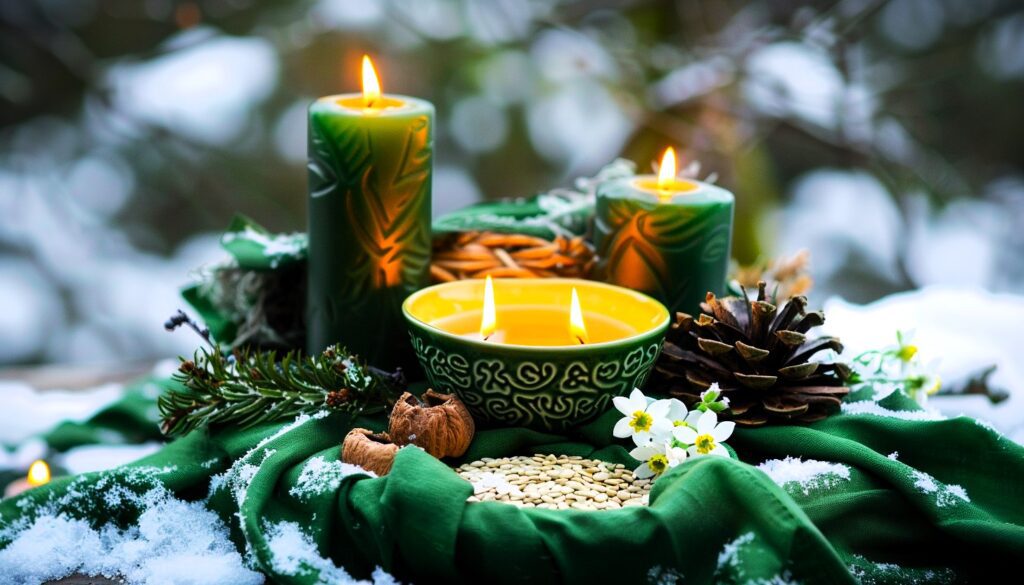


A Spark of Hope: A Simple Imbolc Ritual
Setting the Scene:
Find a quiet space in your home, perhaps bathed in the soft glow of morning light. Create a sacred area on your altar with a white or green cloth. Decorate it with candles (white and yellow), white flowers like snowdrops, and any crystals associated with purification or new beginnings (clear quartz, amethyst).
Opening the Ceremony:
Light the white candle in the center of your altar. Cast a circle around your space, following a tradition you feel comfortable with (visualizing white light, walking with incense, etc.). Call upon the spirits of the season, the energy of Brigid (Celtic fire goddess), and the promise of spring’s renewal:
“As the days lengthen and the earth awakens, we gather to celebrate Imbolc. Welcome, spirits of light and hope!”
Purification Ritual:
Smudge yourself and the space with cleansing herbs like rosemary or sage. Focus on releasing any negativity or stagnation that may be holding you back. As the smoke rises, visualize it carrying away unwanted thoughts and burdens. Take a few moments to meditate on letting go.
Candle Magick:
Light the yellow candle, symbolizing the returning sun and your own inner fire. Close your eyes and set your intentions for the coming season. Write these intentions on a small piece of paper. Fold the paper and hold it above the flame, visualizing your desires burning bright with the candle’s light. Let the paper burn completely in a safe container.
Seed Planting Ceremony:
Prepare small pots with soil. Choose seeds that represent your intentions – herbs for growth, flowers for beauty, vegetables for abundance. Plant the seeds with care, focusing on the potential within them. As you plant, visualize your own desires taking root and flourishing.
Simple Brigid’s Day Offering:
Offer something homemade to Brigid, the goddess of creativity and hearth. This could be a piece of bread you baked yourself, a poem you wrote about the season, or a small craft you created.
Closing the Ceremony:
Thank the spirits of the season and Brigid for their presence. Gently release the circle you cast. Take a grounding moment, feeling your connection to the earth. Open your eyes, feeling refreshed and ready to welcome the spark of hope that Imbolc brings.
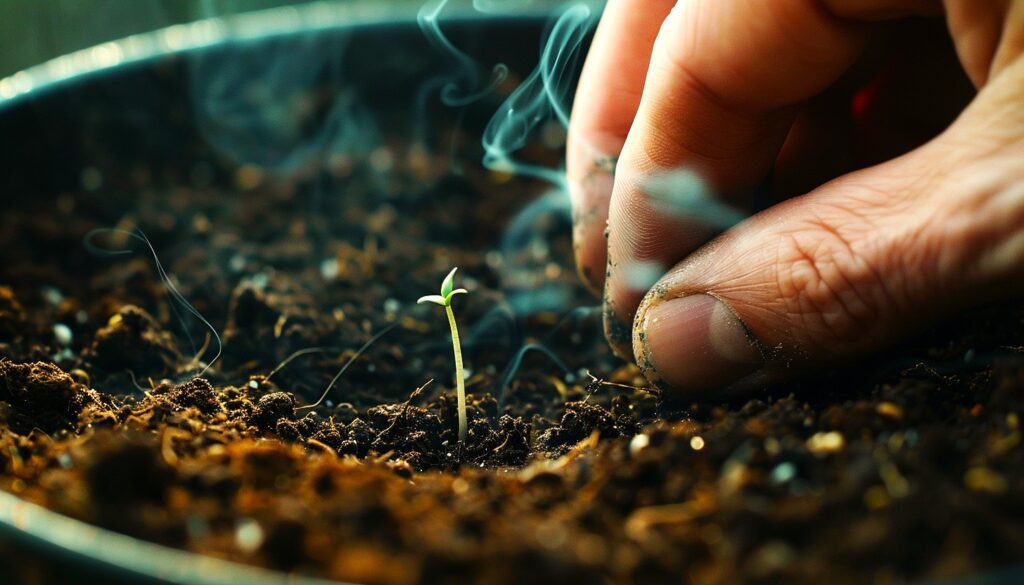


Imbolc’s Whisper: Embracing the Spirit Beyond Ritual
Imbolc, the Celtic festival marking the beginning of spring, is more than just lighting candles and casting circles. It’s a season brimming with the quiet magick of renewal and the promise of longer, brighter days. Here’s how you can embrace the spirit of Imbolc and awaken the potential for growth within yourself:
Spring Cleaning for the Soul:
Just as nature sheds its winter coat, Imbolc is a perfect time to declutter your physical and spiritual space. This doesn’t have to be a daunting task. Start by tidying a drawer, organizing your desk, or donating unused clothes. As you declutter, visualize letting go of negativity, stagnant energy, or limiting beliefs. Make space for the new beginnings Imbolc whispers about.
Planting the Seeds of Your Desires:
Imbolc’s association with fertility extends to our dreams and aspirations. Take time to set intentions for the coming season. What seeds do you want to plant in your life? Do you crave a new skill, a creative project, or a shift in perspective? Write down your goals, visualize them taking root, and nourish them with daily affirmations and action steps.
Embracing New Beginnings:
Imbolc’s energy encourages us to break free from winter’s slumber and embrace fresh starts. Have you been putting off a project or hesitant to try a new approach? This is the time to take that first step! Maybe it’s signing up for a class, starting a blog, or simply trying a new recipe. Imbolc’s gentle push can nudge you towards exciting possibilities.
Connecting with Nature’s Awakening:
Step outside and immerse yourself in the subtle signs of spring. Notice the lengthening daylight, the gentle warmth in the sun’s rays, or the first buds pushing through the soil. Take a walk in nature, listen to the birdsong, and feel the renewed energy of the earth. This reconnection with the natural world can spark inspiration and a sense of harmony within you.
A Heart Full of Gratitude:
Imbolc reminds us to appreciate the small victories and the beauty of the changing seasons. Take a moment each day to reflect on what you’re grateful for: the extra sunlight, the promise of warmer days, or simply the feeling of hope that Imbolc brings. This practice cultivates a positive outlook and opens your heart to new possibilities.
By incorporating these practices, you can extend the spirit of Imbolc beyond ritual. Let it be a catalyst for personal growth, a reminder to nurture your dreams, and a celebration of the inherent potential for renewal that lies within us all. As the days lengthen and the earth awakens, embrace the whisper of Imbolc and embark on a journey of personal springtime.
Spark Joy in Spring: Imbolc Crafts and Activities for Kids!
Imbolc, the festival of light returning, is the perfect time to celebrate with your little ones! Here are some fun activities to introduce them to the magick of spring:
Planting the Seeds of Fun:
- Sprout a Tiny Garden: Let your child witness the miracle of life! Plant easy-to-grow seeds in pots and decorate them with colorful markers.
- Clay Critters: Mold some springtime joy with air-dry clay! Have your child create playful lambs or other baby animals to celebrate new beginnings.
Celebrating Spring’s Arrival:
- Blooming Crowns: Construction paper transforms into vibrant flowers! Help your child create a beautiful flower crown to adorn their head and welcome spring.
- Seed Bomb Surprise: These little seed balls are bursting with potential! Mix wildflower seeds with compost and create mini seed bombs to toss across your yard, creating a future wildflower haven.
- Nature’s Journal: Spring is a treasure trove for curious minds! Decorate a nature journal together and use it to document the wonders your child finds on walks, from colorful blooms to chirping birds.
These engaging activities spark children’s creativity, connect them with nature’s beauty, and introduce them to the joy of Imbolc!
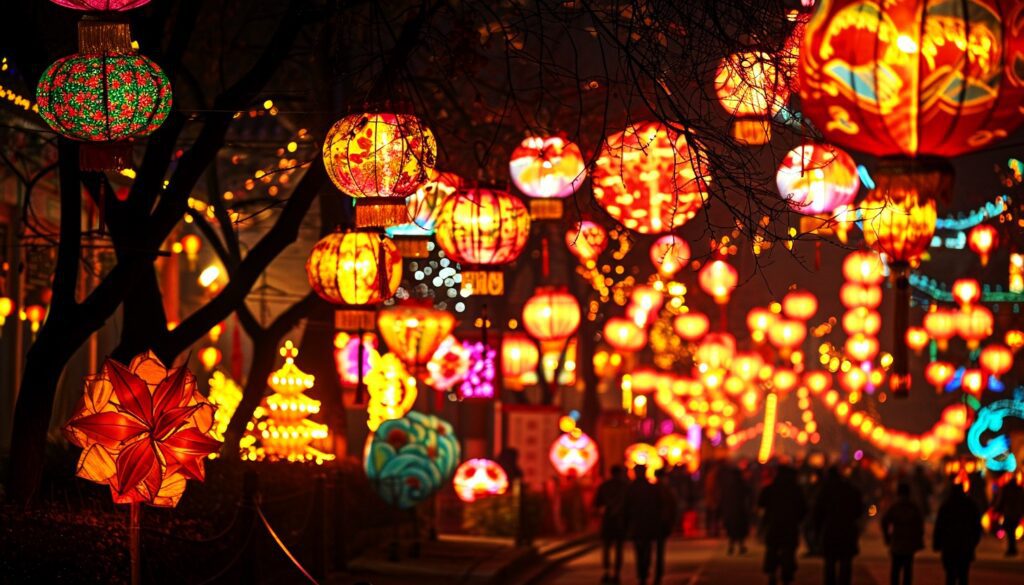


Imbolc’s Global Glow: Celebrating Light’s Return Around the World
Imbolc, a Gaelic festival marking the halfway point between winter and spring, isn’t alone in its celebration of light’s gradual return. Here’s a glimpse into how other cultures around the world welcome the banishing of winter’s darkness:
Japan’s Joyful Bean-Throwing (Setsubun):
Across Japan, February 3rd explodes with activity during Setsubun. This lively festival aims to ward off evil spirits and welcome good luck for the coming year. Families gather, armed with roasted soybeans, and shout “Oni wa soto! Fuku wa uchi!” (“Demons out! Luck in!”). Laughter fills the air as everyone throws beans outside, symbolically driving away misfortune.
China’s Dazzling Lantern Displays (Lantern Festival):
Falling around the same time as Imbolc, China’s Lantern Festival marks the grand finale of the Lunar New Year celebrations. Cities come alive with a mesmerizing spectacle of intricate paper lanterns illuminating streets and parks. Parades featuring these glowing creations, accompanied by music and dance, add to the festive atmosphere. The vibrant displays symbolize letting go of the past and embracing the hope of a bright future.
Germany’s Candlemas Traditions:
In parts of Europe, particularly Germany, February 2nd is observed as Candlemas, a Christian holiday with roots intertwined with Imbolc’s pagan traditions. Churches hold special candlelit processions, symbolizing the purification of the Virgin Mary and the presentation of Jesus at the temple. Candlemas blessings are also bestowed upon lit candles, believed to bring protection and good fortune throughout the year.
These global celebrations, though unique in their traditions, share a common thread – the joy of welcoming back the light and the hope it brings for a flourishing spring season. So, as you celebrate Imbolc, remember that you’re part of a global tapestry of cultures lighting the path towards brighter days.
Imbolc’s Gentle Light: Awaken Your Spirit for Spring
Imbolc, a Gaelic festival marking the midpoint between winter’s slumber and spring’s awakening, is a time for quiet reflection and joyful anticipation. It’s a season of purification, washing away the heaviness of winter and preparing for the vibrant growth to come.
Light Pierces the Darkness:
Even in the heart of winter, Imbolc reminds us that darkness doesn’t reign forever. As days slowly lengthen, the festival ignites a spirit of hope, symbolizing the gradual return of light and the promise of spring’s warmth.
Renewal and Rebirth Bloom:
Imbolc celebrates the potential for new beginnings. Just as the earth stirs from its winter slumber, Imbolc encourages us to plant seeds of intention, nurture creative ideas, and embrace personal growth.
Embrace Imbolc’s Magick:
Whether you light a candle to honor the returning light, create a vision board for your goals, or simply take a nature walk to appreciate the subtle signs of spring, there are countless ways to connect with Imbolc’s magick.
Cleanse and Rejuvenate:
Let Imbolc be a gentle nudge to cleanse your space, both physically and metaphorically. Declutter your surroundings, clear negative thoughts, and make room for the new beginnings this season promises.
Embrace the Potential Within:
Embrace the spirit of renewal and ignite your creativity. Spring is on the horizon, and Imbolc reminds us that even in the coldest darkness, the potential for growth and light always lies within.
Celebrate Imbolc’s Blessings:
So, celebrate Imbolc in whatever way feels most meaningful to you. Let the gentle light of this season inspire you, and step forward with the hope and optimism that Imbolc brings.
